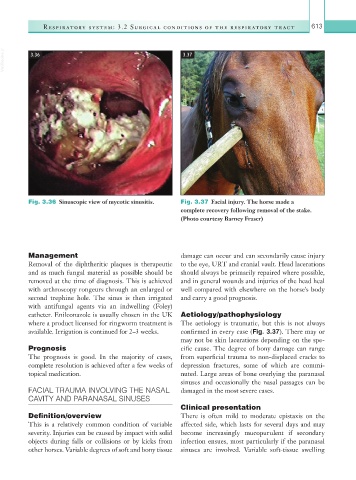Page 638 - Equine Clinical Medicine, Surgery and Reproduction, 2nd Edition
P. 638
Respir atory system: 3.2 Surgical conditions of the respir atory tr act 613
VetBooks.ir 3.36 3.37
Fig. 3.36 Sinuscopic view of mycotic sinusitis. Fig. 3.37 Facial injury. The horse made a
complete recovery following removal of the stake.
(Photo courtesy Barney Fraser)
Management damage can occur and can secondarily cause injury
Removal of the diphtheritic plaques is therapeutic to the eye, URT and cranial vault. Head lacerations
and as much fungal material as possible should be should always be primarily repaired where possible,
removed at the time of diagnosis. This is achieved and in general wounds and injuries of the head heal
with arthroscopy rongeurs through an enlarged or well compared with elsewhere on the horse’s body
second trephine hole. The sinus is then irrigated and carry a good prognosis.
with antifungal agents via an indwelling (Foley)
catheter. Enilconazole is usually chosen in the UK Aetiology/pathophysiology
where a product licensed for ringworm treatment is The aetiology is traumatic, but this is not always
available. Irrigation is continued for 2–3 weeks. confirmed in every case (Fig. 3.37). There may or
may not be skin lacerations depending on the spe-
Prognosis cific cause. The degree of bony damage can range
The prognosis is good. In the majority of cases, from superficial trauma to non-displaced cracks to
complete resolution is achieved after a few weeks of depression fractures, some of which are commi-
topical medication. nuted. Large areas of bone overlying the paranasal
sinuses and occasionally the nasal passages can be
FACIAL TRAUMA INVOLVING THE NASAL damaged in the most severe cases.
CAVITY AND PARANASAL SINUSES
Clinical presentation
Definition/overview There is often mild to moderate epistaxis on the
This is a relatively common condition of variable affected side, which lasts for several days and may
severity. Injuries can be caused by impact with solid become increasingly mucopurulent if secondary
objects during falls or collisions or by kicks from infection ensues, most particularly if the paranasal
other horses. Variable degrees of soft and bony tissue sinuses are involved. Variable soft-tissue swelling

